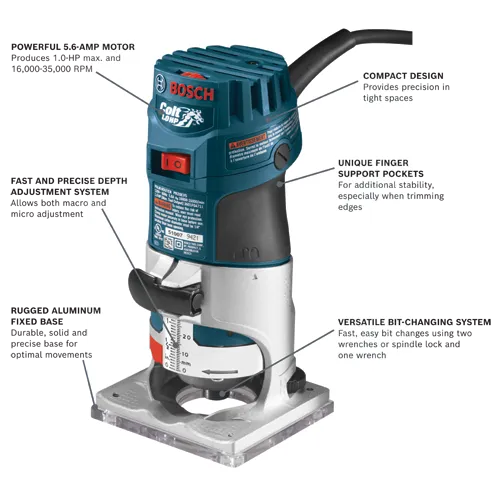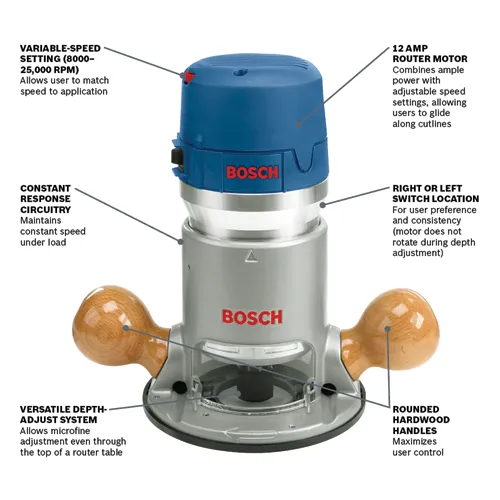Are you ready to transform your woodworking projects from ordinary to extraordinary? If so, mastering the Bosch router can be your game-changer.
This versatile tool is essential for anyone looking to add precision and flair to their creations. Whether you’re smoothing edges, carving intricate designs, or crafting perfect joints, the Bosch router can make it all possible. But, if you’re new to this tool, you might feel overwhelmed by its power and potential.
Don’t worry; this guide is here to help you unlock its full capabilities. Imagine the satisfaction of creating perfectly finished pieces that not only meet but exceed your expectations. By the end of this article, you’ll have the confidence to tackle any project with your Bosch router, turning your creative visions into reality. Ready to dive in and discover the secrets to using your Bosch router like a pro? Let’s get started!

Credit: www.boschtools.com
Contents
Choosing The Right Bosch Router
Selecting the right Bosch router can enhance your woodworking projects. Explore various models to find one that fits your needs. Learn to use it effectively for precise and efficient results.
Choosing the right Bosch router can transform your woodworking projects from ordinary to extraordinary. With a variety of options available, selecting the perfect router might seem overwhelming. But don’t worry, by understanding the different types and essential features, you can make a confident decision that suits your needs and elevates your craftsmanship.Types Of Bosch Routers
Bosch offers a range of routers, each catering to different requirements. – Fixed-Base Routers: Ideal for precision work, they are great for edge cutting and fine detailing. If you enjoy crafting intricate designs, a fixed-base might be your go-to choice. – Plunge Routers: These are versatile tools perfect for tasks that require depth adjustment. Whether you’re creating grooves or mortises, plunge routers allow you to start cutting in the middle of your workpiece. – Combo Routers: Offering the best of both worlds, combo routers come with interchangeable bases. If you’re looking for flexibility, they provide the option to switch between fixed-base and plunge modes as needed. Consider your primary tasks and choose the type that aligns with your projects.Features To Consider
When selecting a Bosch router, several features should be on your radar. – Power: Higher horsepower ensures smooth cuts through tougher materials. If you often work with hardwoods, opt for a router with at least 2 horsepower. – Speed Control: Variable speed settings allow you to adapt to different materials and bit sizes. Adjusting the speed can prevent burning and give you a cleaner finish. – Ergonomics: Comfort is key during long woodworking sessions. Look for routers with soft-grip handles and a balanced design to reduce fatigue. – Dust Collection: A router with a dust collection system keeps your workspace clean and improves visibility. This is especially useful if you work indoors or on large projects. – Ease of Bit Change: Quick and easy bit changes can save you time. Consider routers with a spindle lock for faster transitions between tasks. Have you ever struggled with a tool that just didn’t fit your needs? Choosing the right features can make all the difference in your woodworking experience. As you explore your options, think about what aspects are most crucial for your projects and how each feature aligns with your goals.
Credit: www.youtube.com
Essential Safety Precautions
Ensure safety by wearing protective eyewear and gloves while using a Bosch router. Secure your workpiece firmly to prevent movement during operation. Keep fingers and clothing away from the router bit at all times.
When using a Bosch router, keeping safety at the forefront is crucial. This powerful tool can transform your woodworking projects, but it also demands respect and caution. Before you dive into your next project, consider these essential safety precautions to protect yourself and your workspace.Protective Gear
Wearing the right protective gear can make a significant difference in your safety. Always wear safety goggles to shield your eyes from flying debris. Dust masks are essential to prevent inhaling fine particles that can harm your lungs. Your hands are your primary tools when operating a router, so protect them with well-fitted gloves. However, ensure they do not interfere with your grip. Hearing protection is also crucial, especially if you use the router for extended periods. Loud noises can damage your hearing over time.Workspace Preparation
A well-organized workspace is not just efficient; it’s a safe environment. Start by ensuring your work area is clean and free from clutter. Loose items can become hazards if they get caught in the router or cause you to trip. Secure your workpiece firmly before you start routing. Movement during routing can lead to mistakes and accidents. Use clamps to hold the wood in place, providing stability and precision. Good lighting is another critical factor. You must clearly see the router bit and the material you are working on. Poor visibility can lead to errors and accidents. Consider setting up your workspace near a window or using a bright work lamp. Have you ever considered how your workspace layout affects your safety? Organizing your tools within easy reach minimizes unnecessary movement and enhances focus. This simple step can prevent accidents and improve your efficiency. Remember, safety is not just about wearing gear or preparing your workspace—it’s about adopting a mindset of caution and responsibility. Prioritize these safety measures, and you’ll not only protect yourself but also enjoy a more satisfying and productive woodworking experience.Setting Up Your Bosch Router
Setting up your Bosch router is crucial for optimal performance. Proper setup ensures precision and smooth operation. Follow these steps to get your router ready for use. Each aspect is vital for achieving the best results in your woodworking projects.
Attaching Router Bits
Begin by selecting the appropriate router bit for your task. Ensure the bit is clean and free of damage. Insert the router bit into the collet. Tighten the collet securely using the provided wrench. A firm attachment prevents wobbling during operation.
Adjusting Depth Settings
Determine the required depth for your cut. Use the depth adjustment knob to set the desired depth. Check the depth with a test cut on scrap wood. Adjust again if necessary until the depth is perfect. Accurate depth settings are key for precise cuts.
Basic Routing Techniques
Using a Bosch router involves understanding basic routing techniques. Start by securing your wood piece firmly. Adjust the router depth for desired cuts, ensuring safety and precision. Practice on scrap wood to familiarize yourself with the router’s speed and control.
Always wear safety gear for protection.
Routing with a Bosch router opens up a world of woodworking possibilities. Whether you’re a hobbyist or a seasoned woodworker, mastering basic routing techniques can significantly enhance your projects. Understanding these foundational skills not only improves your craftsmanship but also boosts your confidence to tackle more complex tasks.Edge Routing
Edge routing is a fundamental technique that involves shaping the edges of a piece of wood. It can transform a plain board into an elegant piece with decorative profiles. Imagine turning a simple tabletop into a conversation starter with beautifully rounded or beveled edges. To get started, secure your wood firmly to prevent any movement. Choose a router bit that matches the profile you desire. Adjust the depth of your bit to control how much wood you remove. Always move the router against the rotation of the bit for a smoother finish. Do you notice how a simple edge detail can elevate your entire project?Groove And Slot Cutting
Creating grooves and slots is essential for joinery and adding decorative elements. It’s a technique where precision pays off, allowing components to fit together seamlessly. Start by marking the area where you want the groove or slot. Use a straight edge or guide for accuracy. Select a straight bit that matches the desired width of your groove. Adjust the router’s depth to ensure consistency throughout the cut. With your Bosch router, you can make multiple passes to reach the full depth, especially for deeper grooves. What new projects could you undertake by mastering this technique? Both edge routing and groove cutting are foundational yet powerful techniques that can transform your woodworking projects. They offer endless possibilities for creativity and functionality. Ready to take your skills to the next level with your Bosch router?Advanced Techniques For Precision
Harness the full potential of a Bosch Router by mastering its advanced techniques. Achieve precision in woodwork with simple adjustments and optimal speed settings. Elevate your craftsmanship by exploring diverse cutting profiles and smooth finishes.
Advanced techniques with a Bosch router can elevate your woodworking projects to a new level of precision. These skills can be the difference between a good project and a great one. When you master these techniques, you’ll likely find yourself asking, “Why didn’t I try this sooner?”Template Routing
Template routing is a game-changer for achieving consistent shapes and patterns. Start by creating or purchasing a template that matches the design you want to replicate. Secure your template to the workpiece using clamps or double-sided tape to ensure it doesn’t move. Use a flush-trim bit or a pattern bit with a bearing that follows the template. This bit allows the router to cut exactly along the template’s edge, giving you precise results. Remember to keep a firm grip on the router and move it in a steady manner to avoid slips.Inlay Work
Inlay work adds intricate designs to your projects, enhancing their visual appeal. Choose a contrasting material for your inlay to make it stand out. Begin by sketching your design on the workpiece and then carefully rout out the area for the inlay. Using a router bit that matches the inlay’s thickness ensures a snug fit. If you’re working with intricate patterns, consider a smaller bit for detailed work. Once the inlay is glued and set, sand the surface for a smooth finish. Have you ever thought about how much detail you can add with just a few more steps? By exploring template routing and inlay work, you can transform ordinary pieces into extraordinary masterpieces.
Credit: www.boschtools.com
Maintenance And Care
Proper care ensures your Bosch router works smoothly and lasts longer. Clean the router regularly to remove dust. Check the bits for wear and replace them if needed.
Maintaining and caring for your Bosch router is essential to ensure its longevity and performance. Proper maintenance not only extends the life of your tool but also guarantees precise and efficient work on your projects. Let’s dive into some practical steps you can take to keep your Bosch router in top shape.Cleaning The Router
After every project, it’s crucial to clean your Bosch router. Dust and debris can accumulate quickly, affecting its performance. Use a soft brush to gently remove any sawdust from the surface and the vents. Pay special attention to the bit area. A clean bit ensures smooth cuts and reduces wear on the motor. Compressed air can be handy for getting into tight spots where debris might be trapped. Check for any resin build-up on the router’s base and bit. This can hinder movement and precision. A gentle wipe with a damp cloth usually does the trick. Avoid using harsh chemicals that might damage the surfaces.Storing Properly
Proper storage is just as important as cleaning. When you’re done, unplug the router and wrap the cord neatly. Avoid sharp bends to prevent damage. Store your router in a dry, cool place. Moisture can cause rust and damage electrical components. A dedicated cabinet or tool bag can keep it safe from dust and accidental knocks. Consider using a silica gel packet in your storage area. This helps absorb any moisture in the air. It’s a small step that can make a big difference in maintaining your tool. By taking these steps, you ensure your Bosch router remains a reliable partner in your woodworking projects. Remember, a well-maintained tool is a joy to use, and it can significantly impact the quality of your work. Are you giving your Bosch router the care it deserves?Troubleshooting Common Issues
Using a Bosch router can sometimes present challenges. Common issues include poor bit performance and uneven cuts. Regular maintenance and checking bit sharpness can help solve these problems.
Even with the best tools like a Bosch Router, sometimes things don’t go as planned. Whether you’re a seasoned woodworker or a DIY enthusiast, encountering issues is part of the journey. Understanding common problems and how to fix them can save you time and frustration. Let’s dive into some troubleshooting tips that can keep your projects on track and your spirits high.Motor Problems
A router’s motor is its heart, and like any heart, it can experience hiccups. If your router refuses to start, it might be due to a loose power connection. Check the plug and ensure it’s securely inserted into the outlet. Overheating can also be a concern. If the motor feels too hot, let it cool down before resuming work. Consider if dust buildup is blocking ventilation. Clean the vents regularly to maintain airflow and prevent overheating. Sometimes, a strange noise can signal trouble. Listen closely. If you hear grinding or squealing, the motor bearings might be worn out. Replacing them can restore your router to its usual hum.Bit Installation Errors
The bit is where the magic happens, but incorrect installation can lead to headaches. Always ensure the router is unplugged before changing bits to avoid accidents. A common mistake is not tightening the collet properly. This can cause the bit to slip during use. Use a wrench to firmly secure the collet nut, ensuring the bit stays in place. Having trouble with bit alignment? It’s crucial for clean cuts. Align the bit carefully and double-check that it’s centered. A slight misalignment can affect the precision of your work. Have you ever struggled with these issues while using your Bosch Router? Taking these steps can help you solve problems efficiently. This keeps your projects smooth and your creativity flowing.Expert Tips For Best Results
Discover expert tips to achieve the best results with a Bosch router. Ensure accurate cuts by using the correct bit and maintaining a steady hand. Always prioritize safety by wearing protective gear and securing your workpiece.
Using a Bosch router can greatly enhance your woodworking projects, whether you’re a seasoned pro or just getting started. However, mastering this tool requires more than just turning it on. To ensure you get the best results every time, here are some expert tips that you can easily incorporate into your work. These insights will not only improve the quality of your cuts but also make your experience more enjoyable and efficient.Choosing The Right Speed
Selecting the correct speed for your Bosch router is crucial. Different materials require different speeds. For hardwoods, a slower speed often works best. Softwoods, on the other hand, can handle higher speeds. Think about the size of the bit as well. Larger bits should be used at slower speeds to avoid burning the wood. Experiment with different settings on a scrap piece to find the sweet spot before you begin your project.Ensuring Smooth Cuts
Achieving smooth cuts is a common goal, but it demands attention to detail. Make sure your router bits are sharp and clean. Dull bits can cause splintering, which is frustrating and time-consuming to fix. Consider the direction of the cut, too. Always move the router against the direction of the bit’s spin. This gives you more control and results in a cleaner cut. Remember, practice makes perfect, so don’t hesitate to refine your technique with some trial runs. For those tricky edges, take multiple passes instead of trying to cut everything at once. This reduces the load on the router and minimizes the risk of errors. Have you ever rushed a cut, only to regret it later? Take your time; the results will speak for themselves. These expert tips are just the beginning. With practice and patience, you’ll find your own rhythm and style with your Bosch router. Dive in, explore the possibilities, and watch your woodworking skills soar to new heights.Conclusion
Using a Bosch router can enhance your woodworking projects. It’s all about precision and control. Practice makes perfect, so start with simple tasks. Always prioritize safety. Wear goggles and gloves. Read instructions carefully. Experiment with different bits. This helps you find the right fit for your project.
Don’t rush the process. Take your time to get familiar with the tool. This builds confidence. Enjoy the process. Crafting becomes more enjoyable with experience. Make sure to maintain your router. Clean it regularly for best performance. Happy woodworking!

